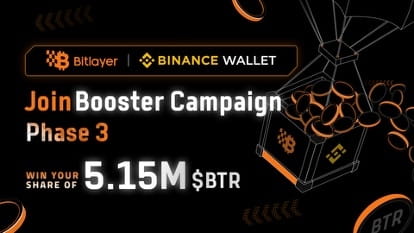Written by: Qingfengbtc / August 23, 2025
While Ethereum, Solana, and Layer2 are experiencing a surge, Bitcoin, the 'veteran player,' remains at the top of the cryptocurrency market cap rankings.
However, as the safest, most censorship-resistant, and most globally recognized asset, Bitcoin has always stagnated in functional development.
This inevitably leads one to think:
What is the next evolutionary direction for Bitcoin?
Recently, the emergence of Bitlayer has provided a possible answer.
It is not another sidechain, not a meme project, nor an L2 for BTC, but aims to provide BTC with true 'smart execution capabilities' starting from the underlying logic of protocol design.
This article will break down Bitlayer's development path and potential prospects from four dimensions.
1) BTC: The largest yet most 'silent' asset in the world
Bitcoin has the strongest consensus, the longest operating record, and the broadest user base.
But it also has three obvious 'shortcomings':
No smart contracts, cannot support complex applications
The on-chain ecology is barren and lacks efficiency in capital flow.
Lacks native interoperability mechanisms with multi-chain ecosystems.
These issues have been magnified over the past few years.
In contrast, Ethereum's smart contracts have given birth to complete ecosystems like DeFi, NFT, DAO, etc.; whereas BTC still behaves like 'gold bars,' only able to be held and transferred, but not operated or earn interest.
2) Bitlayer's Vision: Not to 'redo BTC,' but to 'make it smarter.'
The core philosophy of Bitlayer is not to replace BTC, but to **'extend the capability boundaries of Bitcoin.'**
Its positioning is very unique:
✅ Not a second-layer expansion of Bitcoin (such as Lightning)
✅ Not a new public chain or forked chain.
✅ Instead, it is a 'smart execution layer' based on the BitVM architecture.
In other words, it allows BTC itself to run contract logic and asset calculations in a safer and lighter way through a new verification model, without modifying the rules of Bitcoin itself or forcibly introducing PoS or external consensus mechanisms.
Core Mechanism: BitVM
BitVM is currently one of the most attention-grabbing experimental designs in the BTC ecosystem.
Its value lies in:
More complex computations can be achieved without soft or hard forks of Bitcoin.
Introduce ZK verification, challenge response mechanisms to ensure security.
Build the possibility of a 'contract + cross-chain + application' trinity.
This is not only a technological innovation but also provides an execution entry point for reconstructing applications in the Bitcoin ecosystem.
3) Bitlayer's Planning Layout: From Cross-Chain Bridge to Yield-Bearing BTC, and then to Ecological Expansion
Bitlayer is not just a 'VM layer concept'; it has already implemented multiple component modules, forming an initial system:
1) BitVM Cross-Chain Bridge
Achieve low-trust asset transfers between BTC and other chains.
Avoid centralized bridging solutions, using challenge mechanisms for validation.
2) YBTC Yield Asset Mechanism
Anchor BTC as a yield-bearing asset
Support BTC staking, re-staking, and composite strategy access.
3) BTC Liquidity Aggregator
Aggregate on-chain BTC assets (such as wBTC, sBTC, YBTC)
Open up cross-chain liquidity, improve asset composability.
In the future, Bitlayer will also launch:
BTC Native DEX
Stablecoin Contract System
NFT / Chain Game Payment Component
Developer Toolkit (SDK + API)
The project party clearly stated: It will prioritize the construction of developer-friendly interfaces and low-threshold interactive environments to attract more holders of native BTC assets to participate.
4) Bitlayer's Future Prospects: How likely is it to position itself as the 'smart layer' of the BTC ecosystem?
Currently, the ecological narrative of BTC is returning to the mainstream.
Runes, Ordinals, BRC20 showcase Bitcoin's immense potential in the 'asset layer,' but in terms of smart logic and protocol execution capabilities, it remains blank.
The success or failure of Bitlayer may very well become the watershed for whether this gap can truly be filled.
🚩 We believe its core opportunities lie in three points:
Ecological strategy is correct: Choosing a compatible path to enter without changing the essence of BTC can gain broader acceptance from developers and asset holders.
Security prioritization is correct: Instead of rushing to 'run applications,' it starts from the cross-chain bridge and the basic modules of the asset layer, progressing steadily.
Early ecological dividends: Currently, there is no smart execution platform like Bitlayer on BTC, making the first mover advantage clear.
5) Summary: Not all 'Bitcoin evolution' projects are worth watching, but Bitlayer is worth studying.
In an increasingly fragmented Web3 ecology, where narratives frequently change, projects that can calmly address fundamental issues are even more scarce.
Bitlayer does not follow a traffic route or pursue short-term quick money logic; it aims at the difficult yet important task of 'the long-term evolution of BTC.'
Can it become the 'Solidity' of the Bitcoin world?
Can it enable BTC to have its own 'DeFi + contract ecosystem'?
We cannot predict everything, but at least, it is currently one of the most solid paths.
Task activities are still ongoing; future airdrops, mainnet launches, token designs, etc., may become the rewards for your in-depth research today.




